Cassia fistula
Indian Laburnum, Purging Cassia, Cassia SolutivaAmaltas (Unani)
Amaltas (Hindi)
Arag-vadha (Sanskrit)
Dong ga དོང་ག (Tibetan)
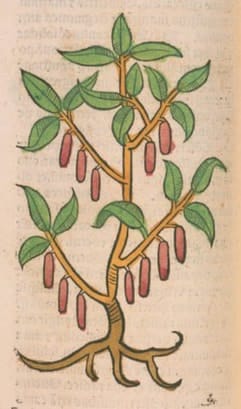 Ortus Sanitatis, Meydenbach, 1491
Ortus Sanitatis, Meydenbach, 1491
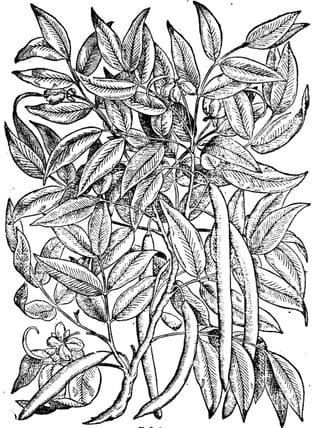
|
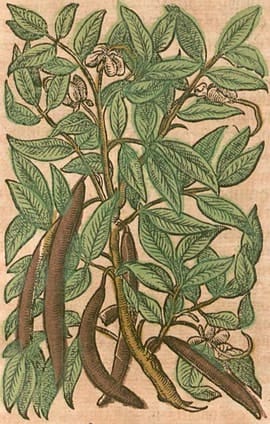
|
|
New Kreuterbuch, Matthiolus, 1563 |
Krauterbuch, Lonitzer, 1578 |
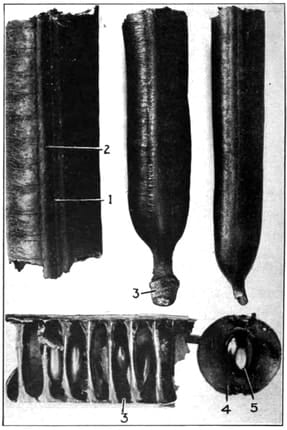 CASSIA FISTULA
CASSIA FISTULA1, 2. Grooves and ridges on one side of the fruit.
3, Short stout pedicle. 3 (lower), Shows the cross partitions
and several seeds. 4, Round disk (portion) covered with pulp.
5, Shiny seed. Squibb’s Atlas of the Official Drugs, Mansfield, 1919
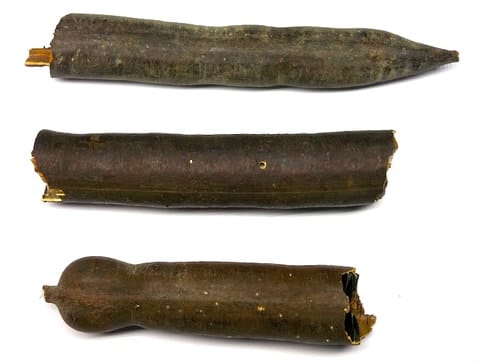 Cassia Fistula (Adam, 2019)
Cassia Fistula (Adam, 2019) Members CLICK HERE for the PRO VERSION
Members CLICK HERE for the PRO VERSIONBotanical name:
Cassia fistula (syn. C. rhombifolia)
Parts used:
Fruit Pulp; also root-bark, seed, leaf
Temperature & Taste:
Fruit Pulp: Warm, moist. Sweet
Root-Bark: Warm, dry
Classifications:
2B ATTENUATERS. 2E LENITIVE. 2G. CLEANSING
TCM:
B. Clears Heat
Uses:
1. Purges Bile:
-gentle and safe laxative; safe for children and during pregnancy
-very good to cleanse the Bowels and Blood after Fever or Heat disease
-clear Heat and Bile from the skin; Hot, inflamed and itchy skin conditions
2. Externally:
-Arthritis, Gout, Rheumatism (india)
-“Purging cassia is painted on gout and painful joints”. (Avicenna)
-“When it is painted on the Hard swellings, it proves to be quite useful”. (Avicenna)
-Snake bite
Dose:
25–50 grams
Correctives:
… available in PRO version
Substitutes:
… available in PRO version

Main Combinations:
1. To purge Bile:
i. Cassia pulp with … available in PRO version
ii. Cassia pulp with … available in PRO version
iii. Cassia pulp … available in PRO version
2. To Purge Phlegm:
i. Cassia pulp with … available in PRO version
ii. Cassia pulp with … available in PRO version
3. To purge Melancholy
i. Cassia pulp with … available in PRO version
ii. Cassia pulp with … available in PRO version.
4. As a purgative in Ayurveda:
i. Cassia pulp with … available in PRO version
ii. Cassia pulp with … available in PRO version
5. Heat and Inflammation of the Skin, Cassia pulp with … available in PRO version
6. Abdominal obstructions, take Cassia pulp with … available in PRO version
Major Formulas
Infusion to Purge Bile and Phlegm (Mesue)
Powder to Facilitate Birth (Renodeus)
Antidotus Acharistos Altera
1. Confection of Cassia / Electuary of Cassia:
i. Cassia pulp (2 oz), Manna, Tamarind pulp (1 oz. each). Mix. (Pharmacopee Usuelle, Louvain, 1821)
ii. Cassia pulp (half pound), Manna (2 oz.), Tamarind pulp (1 oz.), Syrup of Roses (half pound). Dissolve Manna in the syrup with gentle heat of a water bath; then add the pulps, and evaporate to the proper consistency. (London)
iii. Cassia pulp (half pound), Manna (2 oz.), Tamarind pulp (1 oz.), Syrup of Orange (half pound). Dissolve Manna in the syrup with gentle heat of a water bath; then add the pulps, and evaporate to the proper consistency. (Dublin)
iv. Cassia pulp (4 parts), Tamarind pulp, Manna (1 part each), Syrup of Damask Roses (4 parts). Dissolve Manna in the Syrup, add the pulps and evaporate. (Edinborough)
v. Extract of Cassia (160 parts), Syrup of Violets (120 parts), White Sugar (30 parts); evaporate in a water bath to the proper consistency. When cold add Essential Oil of Orange flowers (one hundredth part). Mix. (Pharmacopoeia Gallica, 1818)
Cautions:
Generally very safe
Main Preparations used:
Infusion, Extract, Conserve, Confection
-
Extra Info
-
History
|
‘The pulp contained in the legumes has long been used medicinally by the Hindus. The Sanskrit names for the tree are Aragbadha, Suvarnaka, and Rajataru, or king of trees, on account of the beauty of the long racemes of yellow flowers, which resemble those of the Laburnum, but are much larger. In Hindu medicine the pulp is used as a cathartic, and the root is also sometimes given as a laxative. A compound decoction (Aragbadhadi) is directed to be used by Chakradatta; it contains Cassia pulp, Picrorrhiza Kurroa, Chebulic myrobalans, long pepper root and Cyperus rotundus (Datt’s Hindu Mat. Med., p. 155.) In Mahometan works the drug is called Khiyar-shambar, an Arabic corruption of the Persian Khiyar-chambar, and the pulp Asal-i-Khiyar-chambar (honey of Khiyar-chambar). Chambar means a necklace in Persian, and is probably an allusion to the structure of the pod. Persian dictionaries give Katha-el-Hind (Indian cucumber) as the Arabic name. Through the Arabians the drug became known to the later Greek physicians. Nicolaus Myrepsicus calls it [?]. Joannes Actuarius who practised at Constantinople towards the close of the 13th century, describes it minutely. In the Makhzan-el-Adwiya the pods are directed to be slightly warmed, and the pulp extracted and rubbed up with a little almond oil for use. It is described as |
lenitive, useful for relieving thoracic obstructions, and heat of blood, a safe aperient for children, and women even when pregnant, but slow in its action. With tamarinds it is said to be a good purge for adust bile; with turbith or polypodium for cold humours and melancholy; with linseed or almond oil and combined with other suitable remedies such as Dulcamara it is recommended for the removal of obstructions of tho abdominal viscera. Externally it is said to be a good application in gout, rheumatism, &c. The flowers and leaves are said to have lenitive properties, and a conserve of the former is mentioned. From 5 to 7 of the powdered seeds are prescribed as an emetic, and the shell of tho pod rubbed down with saffron, sugar, and rose water, in difficult parturition. In the Pharrnaco-graphia (p. 195), it is shown that the Cassia fistula of the Greeks and Romans was a kind of cinnamon. Ainslie notices the use of the pulp and flowers by the natives of India, and says that it is mentioned by Avicenna under the name of Khiyar-charabar, also by Serapion, and Prosper Alpinus in his work, “De plantis Aegypti.” Dr. Irvine (Top. of Ajraeer) states that he found the root act as a strong purgative. In the Concan the juice of the young leaves is used to cure ringworm, and to allay the irritation caused by the application of the marking-nut juice’. |
From Pharmacographia Indica, Dymock, 1890
|
‘The Sanskrit names for the tree are Aragbadha, Suvarnaka (golden), and Rajataru, or Nripadrama (royal tree), on account of the beauty of the long racemes, of yellow flowers, which resemble those of the Laburnum, but are much larger. It is sacred to Ganeshwar, the St. Januarius of India; in Mysore stakes cut from the tree are fixed in the ground and worshipped. In Hindu medicine the pulp is used as a cathartic, and the root is also sometimes given as a laxative. A compound decoction (Aragbadliadi) is directed to be used by Chakradatta; it contains Cassia pulp, Picrorrhiza Kurroa, Chebulic myrobalans, long pepper root and Cyperus rotundus. (Dutt’s Hindu Mat. Med., p. 155.) In Mahometan works the drug is called Khiyar-shambar, an Arabic corruption of the Persian Khiyar-chambar, and the pulp Asal-i- Khiyar-chambar (honey of Khiyar-chambar). Chambar means a necklace in Persian, and is probably an allusion to the structure of the pod. Persian dictionaries give Katha-el-Hind (Indian cucumber) as the Arabic name. Through the Arabians the drug became known to the later Greek physicians. Nicolaus Myrepsicus calls it [?]. Joannes Actuarius, who practised at Constantinople towards the close of the 13th century, describes it minutely. In the Makhzan-el-adwiya the pods are directed to be slightly warmed, and the pulp extracted and rubbed up with a little almond oil for use. It is described as lenitive, useful for relieving thoracic obstructions, and heat of blood, a safe aperient for children, and |
women even when pregnant, but slow in its action. With tamarinds it is said to be a good purge for adust [burnt] bile; with turbith or polypodiuin for cold humours and melancholy; with linseed or almond oil and combined with other suitable remedies, such as Dulcamara, it is recommended for the removal of obstructions of the abdominal viscera. Externally it is said to be a good application in gout, rheumatism, &c. The flowers and leaves are said to have lenitive properties, and a conserve of the former is mentioned. From 5 to 7 of the powdered seeds are prescribed as an emetic, and the shell of the pod rubbed down with saffron, sugar, and rose water, in difficult parturition. Ainslie notices the use of the pulp and flowers by the natives of India. Dr. Irvine (Topogr. of Ajmeer) states that he found the root act as a strong purgative. It is also reported to be in use as a purgative in Guzerat. In the Concan the juice of the young leaves is used to cure ringworm, and to allay the irritation caused by the application of the marking-nut juice. Rumphius remarks that the Portuguese make a confection of the young pods and also of the flowers. A peculiar gum swelling up in water like tragacanth issues from the tree when bruised. C. brasiliana and C. moschata, the Cana fistola de purgar of Panama, Petite Casse d’Amerique of the French (cf. Hanbury Science Papers, p. 318), have been introduced into India, and have properties similar to those of C. Fistula. |
